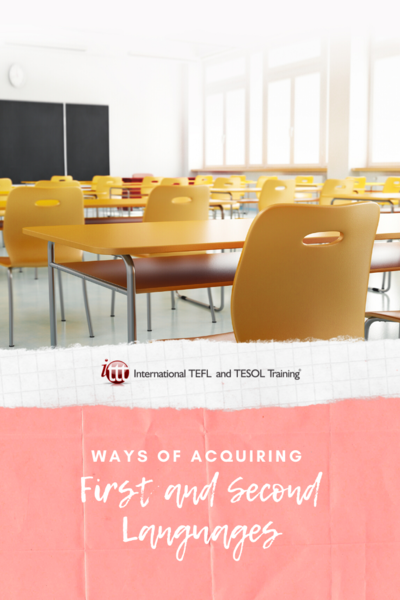Ways of Acquiring First and Second Languages

When we mention a second language, we are referring to a learning context in which the non-native speaker is in a community where the language is used in a large number of situations. This allows the speaker to engage in communicative interactions with both native speakers and other non-native speakers. In can also be the case that the learner is in a context in which exposure to the language occurs mainly in situations of formal learning, in which the linguistic contents are presented sequentially and in a structured way. Thus, both contexts are characterized by significant differences both in the quantity and quality of language stimuli and in the opportunities for participation in communicative interactions that the learner has.
Table of Contents
Do you want to teach English abroad? Take a TEFL course!
This post was written by our TEFL certification graduate Maria Sofia N. Please note that this blog post might not necessarily represent the beliefs or opinions of ITTT.
Irrespective of the contexts mentioned above it is common practice to use the term non-native tongue (L2) to designate any language that is acquired/learned after the native tongue (L1).
First Language
The acquisition of L2 has several characteristics that distinguish it from the acquisition of L1, among which the following can be highlighted:
- the L1 acquisition process begins in the first months of life, L2 is normally acquired later. Normally L2 exposure will not occur before the age of 3 and often occurs only in adolescence or even in adulthood.
- It has been noticed that when L2 expositions start before the age of 8, at least in certain grammatical domains, the developmental process has characteristics in common with the acquisition of L1. It is also known that the ability to develop a native (or rather quasi-native) skill level is lost much earlier in the field of phonology than in the syntax domain.
- the L2 acquisition process is influenced by other several factors such as language, motivation, cognitive styles, learning strategies, personality, attitudes. These factors interact, contributing to the qualitative differences observed between non-native speakers in the way in which knowledge of certain linguistic properties develops, and influencing both the rate of development and the chances of successful acquisition;

Also Read: Should I take a TEFL course online or in a classroom?
Second Language
- the acquisition of a new L2 may be influenced by the speaker's knowledge, not only of his L1, but also of other L2, and may be transferred from any of the previously acquired languages.
- L2 acquisition is characterized by a great deal of variability:
- o visible when comparing several learners who, under the same conditions of acquisition/learning conditions, may differ in the development of their grammatical knowledge and often reach different levels of proficiency;
- o or when comparing the language acquisition of a single learner at a given stage of development;
Results
- many L2 learners never reach a (nearly) native level of proficiency even after prolonged exposure to the target language, often occurring stagnation of linguistic knowledge at the early stages of development.
- contrary to L1, many authors argue that formal education and corrections play a key role in L2 acquisition, although the effect of different types of stimuli on the development of language knowledge (as in passive exposure to language, participation in communicative interactions, exposure to structured linguistic data and grammatical explanations, error correction, reformulations, etc.) continues to be debated.
Also Read: Teaching With The Help of Interesting Resources
Do you want to teach English abroad? Take a TEFL course!
These differences between L1 and L2 have led many researchers to conclude that these are processes of a different nature, culminating in the construction of distinct types of language knowledge: in the case of L1, we are facing a natural process through which children build from the linguistic stimuli to which they are exposed, a system of implicit knowledge of the abstract properties of grammar; In the case of L2, we are in the presence of an active learning process that results in the construction of explicit and conscious grammatical representations.
Apply now & get certified to teach english abroad!
Speak with an ITTT advisor today to put together your personal plan for teaching English abroad.
Send us an email or call us toll-free at 1-800-490-0531 to speak with an ITTT advisor today.
Related Articles:
- How much can I earn teaching English in Taiwan?
- The 8 Best Countries in Asia for Teaching English Abroad
- Top 10 Cities in Asia with the Highest Demand for English Language Teachers
- 7 Steps to Paying Off Your Student Loans While Teaching English Abroad
- Top 10 Cities in China for Teaching English Abroad
- Two Traveling Teachers Share What It's Like Teaching English Abroad as a Couple




